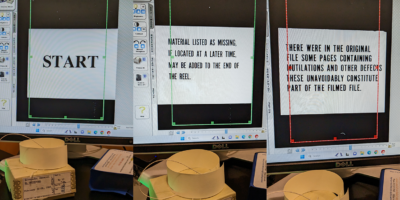By Gwen Shaw
For my first post on Visible Pedagogy, I was going to write about one of my favorite assignments of my own creation, a triple-entry journal. As this semester got off the ground, however, another matter seemed more pressing and pertinent. What do you do when your usual, or planned, method of instruction doesn’t fit with the class you currently have?
Having taught a number of different courses at different schools, I’ve learned how to adapt content to learners in various environments. I’ve also learned how to improvise. In one of my art history survey courses this spring, some of the students are particularly social and my classroom has become a place not just of learning but of meeting, camaraderie, and socialization. These students don’t talk over me, and their lively hum is not to the point of rudeness or disrespect, but it does take more effort on my part to hold their attention (never an easy task) and keep it without chiding, and to maintain continuity as I move between topics of discussion.
The issue, then, is whether the way I had planned to teach the course was the best fit for this especially lively group of students. I realize that just because my approach worked in the past, doesn’t mean that it will work the same way now. Furthermore, the social students are enjoying themselves (or as much as it is possible given the circumstances) which increases the general levity of the room. I like classrooms that can be fun, active, and intellectually engaged, and certainly don’t want to (further) encourage the misconception that education and enjoyment are mutually exclusive enterprises. Instead, I want my students to feel free to be themselves in my classroom, whether that means being silly or serious; to take intellectual risks; to make mistakes; and, yes, to have a good time.
And more practically, it is also exhausting and a poor use of my time to have to constantly nag students to be quiet. Nothing makes me feel more ineffective as an educator than to have to stand in the front of the room, repeating, “Hi, everyone. Okay. Let’s get started. You guys? Are you ready? Can we start? [waits a few moments] Okay, ready? Alright, let’s get started…” I understand that this is a 3-hour night class, and that my students have already had full days before we see each other. And that it’s hard to sit in a darkened room talking about history and works of art, especially late in the day. I acknowledge this, because I strive for an honest relationship with my students built on earnestness, mutual trust, and respect. But repeating myself, and continuing to use methods that aren’t effective, erodes the potency of this message. If the exigencies of this particular course make the lecturing and discussion that I had planned more difficult—hard to pay attention to, hard to stay focused on, hard to engage with and learn—then I realized that a change of course was in order.
So what did I do? Rather than continue with the way that I had taught before, I decided to essentially break down our 3-hour time slot into a series of group projects, structured around several prompts. What did the Sumerians give us that the Akkadians improved upon? How were the Persian and Assyrian imperial programs different? I create worksheets and matrixes for students to complete in pairs or small groups that focus on facts that are most vital to different civilizations. Once students complete them, we go over them together, and look at images to see how specific works of art might bear out their observations about culture. This way, students can supplement each others’ knowledge directly (rather than looking at me for answers). The classroom becomes a place where talking, collaboration, and laughing are encouraged, not discouraged or shushed.
Some logistics: In the same spirit of full disclosure mentioned above, when I decided to make the course correction I was frank with the students and told them that I didn’t think what we had been doing was working. I told them that we would try something different—a little more active, engaged, and independent—and that if it didn’t work out, that was okay too. Making the handouts is a little more time consuming than preparing lecture notes, but much of that process is metacognitive (e.g. thinking about the best way to organize a chart of Egyptian cosmology, or deciding what students most need to know about ancient Mesopotamian culture). I don’t grade these worksheets, but there are tests based on this content, so there is at least some incentive (however extrinsic) to complete them well.
It’s messy and noisy, but by encouraging student-oriented and lateral learning we as educators can create the conditions for students to help each other, and feel the freedom to do so without reprimand. Students who under my previous model were censured for talking are now encouraged to do so, and have become contributors to knowledge we produce in class. And, hopefully, students feel a greater sense of ownership over the information we discuss in class because they had an active role in discovering it.
Gwen Shaw is a doctoral candidate in Art History and a Contributing Writer for Visible Pedagogy.









Leave a Reply